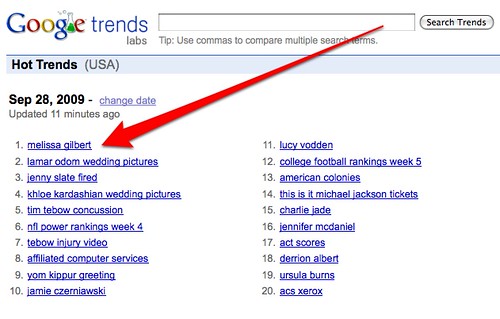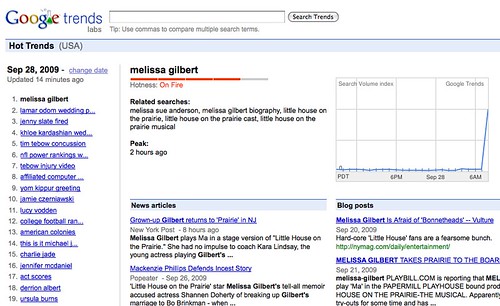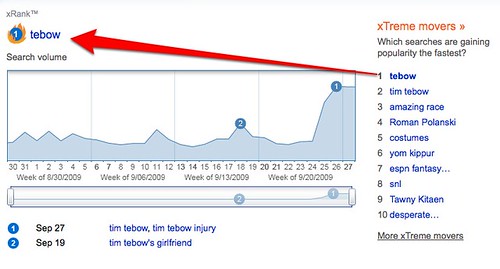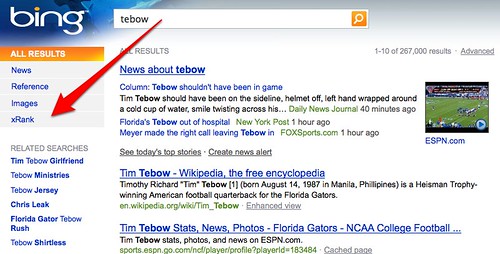Take That, Twitter: Google Hot Trends Integrated Into Google Search
Twitter and real time search continues to attract buzz, and Google’s reacting by positioning its “Hot Trends” information in a place where more people will see it, within Google’s regular search results. Starting around 3:45 Pacific Time today, those searching on topics that are spiking or “hot” in popularity should see a new Hot Trends […]
Twitter and real time search continues to attract buzz, and Google’s reacting by positioning its “Hot Trends” information in a place where more people will see it, within Google’s regular search results.
Starting around 3:45 Pacific Time today, those searching on topics that are spiking or “hot” in popularity should see a new Hot Trends OneBox near the bottom of the search results page and just above the related search area, similar to below:
Here’s another example:
“The idea behind the [Hot Trends] OneBox is to not only provide you with search results as you’d want but also extra meta data on how popular the search is and whether it has peaked in interest, plus the number of sites that are creating chatter and buzz about this particular topic or person, to give a relative hotness rating as well” said RJ Pittman, director of product management for consumer search properties at Google.
From the OneBox, people can then access more information about the topic using the Google Hot Trends service, which was launched in May 2007. (Google Trends itself, the “parent” to Hot Trends, launched in May 2006 and allows people to see how popular many search terms are over time, regardless of how “hot” they are). The boxes show on Google in the United States and Japan.
Hot Trends shows what Google considers to be hottest searches on an hourly basis, searches that many people are suddenly doing. For example, Melissa Gilbert was at the top of the Hot Trends list when I looked earlier today:
Clicking on her name, I can drill in and discover news, blog posts and web results about her. Looking at the news articles in particular, it seems she’s a hot topic today due to her being in a new stage version of Little House On The Prairie:
Why bring Hot Trends into regular Google search results? Pittman said it’s due to the “growth and popularity of real time information.” Places like Twitter allow people to tweet or microblog information within seconds, causing others to turn to them to discover the latest trend in news and current events.
Google realized it has a great source of microblogged content itself, what people put into the Google search box (which recently got bigger).
“Trends is all based on a different kind of tweet. Instead of the 140 character tweet, it’s the 20 to 25 character tweet, the keyword search. And those come in much faster than tweets do. In our view, that’s the highest fidelity information for trending topics,” Pittman said.
What would really make Hot Trends more compelling to me is if there were real time information listed along with the news, blog posts and web page articles shown (see my What Is Real Time Search? Definitions & Players article to better understand what I mean by real time content). Will a “Twitter Results” or “Real Time Results” column be coming? “Not at this time,” said Pittman.
To me, that means Twitter (and to a growing degree, Facebook) will remain a draw for searches where you are seeking immediate confirmation of an event that hasn’t yet gotten news coverage (“Was that an earthquake? “Is the cable out in my area?”).
As part of the new launch, another change has been to reduce the number of Hot Trend topics shown on the Hot Trends home page from 100 to 40. One reason is to help reduce the amount of spam that has sprung up around Hot Trends, misleading or low-content blog posts and web pages created around trending terms in hopes of getting traffic.
“Potentially could be a nice side benefit [spam reduction]. Whenever Google does something like putting together something useful for our users like Trends, these often become targets. We’ve done our best efforts to combat the spam and keep the quality of the list as accurate as possible,” Pittman said.
The main reason for the reduction, however, is to keep those new to Hot Trends from being overwhelmed. Currently, Hot Trends are viewed by people who deliberately seek that type of deep dive into the information. Now, more “regular” searchers may stumble into the area, so Google doesn’t want to “overload” them.
“It’s not that there isn’t value in having a bigger a list, but the bigger the list, the more to wade through,” Pittman said. “I’m not taking that for granted that this is comfortable knowledge for people on Google [what Hot Trends are]. So we’re starting with square one here.”
While the Hot Trends site will only show the top 40 trends for a given hour, the full top 100 list will continue to be used to trigger when a Hot Trends OneBox may show in regular Google search results.
Bing also has a Hot Trends-like service, xRank, launched two years ago this month. But unlike Google’s new Hot Trends OneBox, xRank results remain largely hidden from regular searchers. For example, tebow was the top “mover” in xRank earlier today:
The only way for a regular searcher on Bing to know to explore Tebow’s xRankiness further is if they notice the “xRank” option in the left-hand column, understand what that means, and click on it:
As for Google Hot Trends — watch this space for more, says Google.
“Trends is becoming more relevant than ever. I think this is just the beginning of our efforts in this area,” said Pittman.
For more about Google Trends, see the Google Trends section of our Search Engine Land members library. Here’s also some selected articles:
- Google Meme: Hot Trends Added To Google Trends for more on how it works)
- Google Trends Now Updated Hourly
See also Techmeme for related discussion.
Contributing authors are invited to create content for Search Engine Land and are chosen for their expertise and contribution to the search community. Our contributors work under the oversight of the editorial staff and contributions are checked for quality and relevance to our readers. The opinions they express are their own.
Related stories





